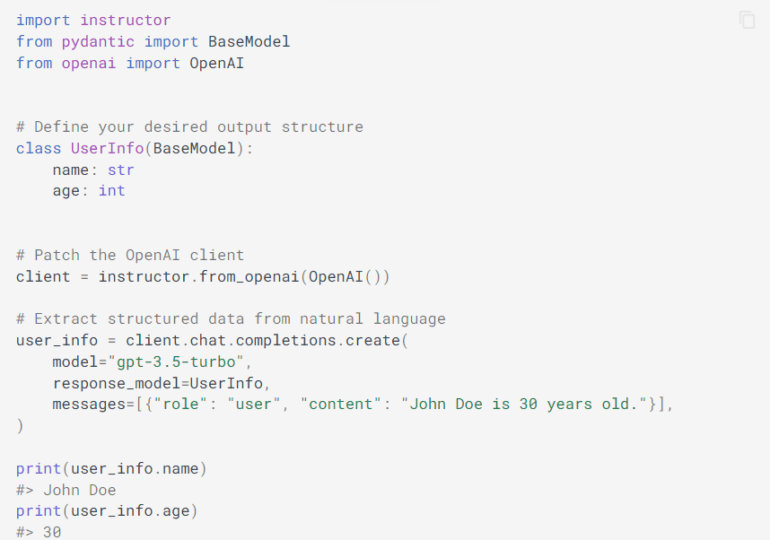- Instructor is a Python library facilitating structured data extraction from cutting-edge language models.
- Key features include precise data model specification, retry management, seamless validation, and streaming support.
- It offers compatibility with various CELM providers and extends utility through CLI functionalities.
- Instructor streamlines workflow complexities, enhancing efficiency and productivity in natural language processing tasks.
Main AI News:
In the domain of natural language processing, the emergence of cutting-edge language models (CELMs) has fundamentally reshaped our approach to textual data. Among the arsenal of tools devised to harness the potential of these sophisticated models, one solution stands as a beacon of simplicity and effectiveness: Instructor.
Instructor, a Python library, streamlines the management of structured outputs from CELMs. Rooted in the reliable framework of Pydantic, it boasts a user-centric API that simplifies tasks such as validation, retry handling, and streamlining responses. With Instructor, navigating the complexities of CELM workflows becomes a seamless endeavor, unlocking unprecedented levels of efficiency and productivity.
Key Attributes:
- Data Models: By defining Pydantic models, users can precisely outline the structure of their CELM outputs, ensuring clarity and coherence in data interpretation.
- Retry Configuration: Instructor empowers users to fine-tune retry attempts, enabling them to tailor requests to specific criteria and constraints.
- Data Validation: Seamlessly integrating Pydantic validation, Instructor guarantees that CELM responses meet predefined standards, minimizing the risk of errors or discrepancies.
- Streamlined Streaming: Whether managing extensive lists or partial responses, Instructor simplifies the process, enabling users to navigate data streams effortlessly and effectively.
- Versatile Compatibility: In addition to its compatibility with OpenAI, Instructor seamlessly integrates with various CELM providers, augmenting flexibility and adaptability in workflow management.
In addition to its robust Python library, Instructor expands its utility through a suite of command-line interface (CLI) functionalities, further enhancing accessibility and convenience:
- Instructor jobs: By simplifying the creation of fine-tuning tasks with OpenAI, users can effortlessly initiate and manage fine-tuned GPT3.5 models.
- instructor files: Seamlessly managing uploaded files, users benefit from functionalities for creation, deletion, and direct uploading via the command line.
- instructor usage: Offering a streamlined approach to usage monitoring, users gain real-time insights directly from the command line, eliminating the need for cumbersome web interfaces.
Instructor epitomizes dedication to simplicity, transparency, and efficiency. It equips users with a robust toolkit to navigate the intricate landscape of CELM workflows. With its intuitive design and powerful capabilities, Instructor represents a significant stride forward in productivity and innovation within the realm of natural language processing.
Conclusion:
The emergence of Instructor signifies a pivotal advancement in the natural language processing market. By offering a robust solution for handling structured data from cutting-edge language models, it addresses a critical need for efficiency and productivity. With its intuitive design and powerful features, Instructor is poised to streamline workflows and drive innovation across various industries reliant on natural language processing technologies. Its compatibility with multiple CELM providers further solidifies its position as a market leader, catering to diverse user needs and preferences. Businesses embracing Instructor can expect enhanced performance and accelerated development in their NLP endeavors, ultimately translating into competitive advantages and growth opportunities.

